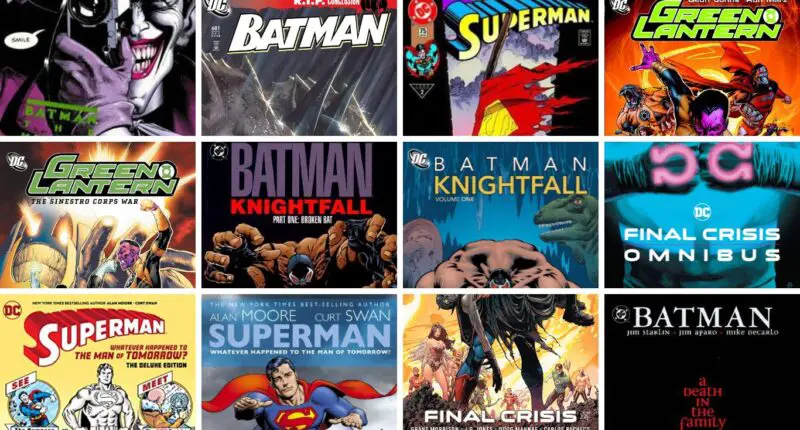DC Comics, a subsidiary of Warner Bros. Entertainment, has been a cornerstone of the comic book industry for decades. Throughout its history, the publisher has produced many memorable and emotionally impactful stories featuring its iconic characters. In this list, we’ll be looking at some of the saddest and most poignant DC Comics storylines of all time. From the death of beloved characters to tales of loss and tragedy, these stories showcase the depth and complexity of the DC Universe and the characters who inhabit it. So, here are the 10 saddest DC Comics of all time.
10 Saddest DC Comics of All Time
The Death of Superman

“The Death of Superman” is a 1992 crossover event that was published across multiple Superman titles. The storyline follows Superman as he engages in a fierce battle against the monstrous creature known as Doomsday. The battle between the two powerful beings ultimately leads to the death of Superman, as he sacrifices himself to save the world from Doomsday’s rampage. The death of Superman was a major event in the DC Universe and had a lasting impact on the characters and storylines that followed. The story arc was a commercial and critical success, and it remains one of the most well-known and poignant storylines in DC Comics history.
Batman R.I.P.

“Batman R.I.P.” is a 2008 storyline that was published across multiple Batman titles. The story arc follows Batman as he is targeted by the villainous Black Glove organization, a group of criminals and wealthy elites who seek to destroy the Dark Knight. The story culminates in an explosion that seemingly kills Batman, leaving the fate of the character in question. The storyline is notable for its use of nonlinear storytelling and its exploration of Batman’s psyche and his relationships with other characters. “Batman R.I.P.” was written by Grant Morrison and illustrated by Tony Daniel, and it was followed by the “Final Crisis” event.
The Killing Joke

“The Killing Joke” is a 1988 one-shot graphic novel that tells the tragic origin story of the Joker, one of Batman’s most iconic and formidable foes. Written by Alan Moore and illustrated by Brian Bolland, the graphic novel explores the Joker’s past and how he became the criminal mastermind he is today. The story also includes a scene in which the Joker paralyzes and tortures Batgirl (Barbara Gordon), leaving her permanently disabled and leading to her taking on the identity of Oracle, a key member of the Batman family. “The Killing Joke” is known for its dark and disturbing themes and its exploration of the complex relationship between Batman and the Joker. It has been widely praised by critics and is considered one of the greatest Batman stories of all time.
Identity Crisis

“Identity Crisis” is a 2004-2005 miniseries that deals with the aftermath of a murder within the superhero community and the psychological toll that being a hero can take on individuals and their loved ones. The story, which was written by Brad Meltzer and illustrated by Rags Morales, revolves around the death of Sue Dibny, the wife of the Elongated Man, and the investigation that follows. The miniseries explores themes of identity, morality, and the consequences of past actions and features the appearance of several DC Comics characters, including the Justice League, the Teen Titans, and the Legion of Doom. “Identity Crisis” was a critical and commercial success and is known for its dark tone and its exploration of complex themes.
Death in the Family

“Death in the Family” is a 1988 storyline that was published across multiple Batman titles. The story arc follows the death of Robin (Jason Todd) at the hands of the Joker, one of Batman’s most iconic and formidable foes. The death of Robin was a major event in the DC Universe and had a lasting impact on the characters and storylines that followed. “Death in the Family” was written by Jim Starlin and illustrated by Jim Aparo, and it is known for its dark and disturbing themes and its exploration of the complex relationship between Batman and the Joker. The story arc was a commercial and critical success and is considered one of the most iconic and memorable Batman stories of all time.
Infinite Crisis

“Infinite Crisis” is a 2005-2006 miniseries that serves as a sequel to “Crisis on Infinite Earths,” a major DC Comics event that was published in the 1980s. “Infinite Crisis” deals with the consequences of the actions of the superheroes in the DC Universe and features the death of several characters. The miniseries, which was written by Geoff Johns and illustrated by Phil Jimenez, explores themes of identity, legacy, and the cost of being a hero and features the appearance of several DC Comics characters, including the Justice League, the Teen Titans, and the Legion of Super-Heroes. “Infinite Crisis” was a critical and commercial success and is considered a key part of the modern DC Comics canon.
Final Crisis

“Final Crisis” is a seven-issue miniseries published by DC Comics in 2009. The story, written by Grant Morrison, focuses on the aftermath of the death of Batman and explores the concept of evil winning in the DC Universe. The miniseries features a wide array of characters from the DC Universe, including Superman, Wonder Woman, and the Flash, as they confront the villainous Darkseid and his minions. The series received critical acclaim for its complex storytelling and its epic scale, and it has been hailed as a classic of modern superhero comics.
Superman: Whatever Happened to the Man of Tomorrow

“Superman: Whatever Happened to the Man of Tomorrow?” is a two-part Superman story written by Alan Moore and illustrated by Curt Swan. It was published in 1986 and serves as a farewell to the Silver Age version of Superman. The story features the death of several characters, including Supergirl, Krypto the Superdog, and Brainiac. It also features the final confrontation between Superman and his arch-nemesis, Lex Luthor. The story is notable for its poignant and emotional portrayal of the end of an era, as well as its impact on the Superman mythos. It has been widely praised as a classic Superman story and is considered one of Moore’s best works.
Batman: Knightfall

“Batman: Knightfall” is a Batman storyline that was published by DC Comics from 1993 to 1994. It follows the aftermath of Batman being broken physically and psychologically by the villain Bane, who destroys the Batcave and defeats Batman in combat. As a result, Batman is forced to take a break from crimefighting and hands over the mantle of Batman to Jean-Paul Valley, also known as Azrael. Valley becomes a more ruthless and violent Batman, using more extreme methods to fight crime. Meanwhile, Bruce Wayne recovers and eventually reclaims the mantle of Batman, leading to a final confrontation with Azrael. The “Knightfall” storyline had a major impact on the Batman mythos and has been adapted into other media, including animated films and video games.
Green Lantern: The Sinestro Corps War

“Green Lantern: The Sinestro Corps War” is a crossover event that was published by DC Comics in 2007 and 2008. It involves multiple Green Lantern titles and deals with the rise of the Sinestro Corps, a group of villains who wield yellow power rings powered by fear. The Sinestro Corps, led by the villain Sinestro, seeks to spread fear throughout the universe and overthrow the Green Lantern Corps, a group of heroes who wield green power rings powered by will. The event features a number of major confrontations between the two groups and culminates in an epic battle on the planet Oa, the home of the Green Lantern Corps. The “Sinestro Corps War” storyline is known for its action-packed plot and its high stakes, and it has been hailed as a classic Green Lantern story. It also had a significant impact on the Green Lantern mythos and has been adapted into other media.
Also Read: Top 10 Young Superheroes from DC Comics



